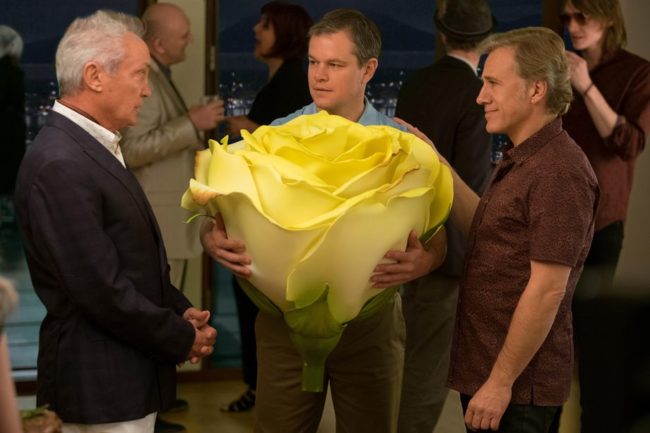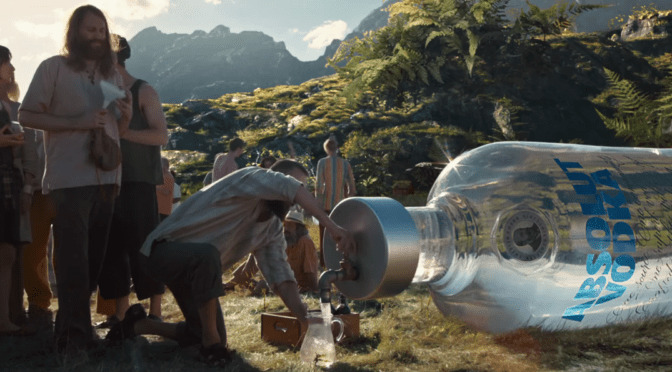Downsizing, the film by Alexander Payne, which follows Paul Safranek (Matt Damon) as he decides to shrink himself to 5 inches tall and moves to the downsized colony of Leisureland, had great promise as a conversation starter about sustainability, and in some ways it succeeded, but in many ways it reinforced the same myths society regularly perpetuates.
The film starts as Norwegians successfully shrink living things to just a percentage of their size. Why? It turns out—as the lead scientist Dr. Andreas Jacobson explains in his lecture “Human Scale and Sustainability”—the experiment was conceived in the 1950s in order to deal with overpopulation. They determined that downsizing was the “only practical and humane solution to humanity’s greatest problem.”
Rebound Effect
First off, there’s the classic problem of the rebound effect. If a person moves to an area where he can sell off his car and get around by bike, his ecological footprint will shrink. Except, now that he spends less on transportation, he ends up spending those savings on other goods, and in the end may have an even larger ecological impact. This is known as the rebound effect.
In shrinking down to 5”, we’re talking about a reduction in consumption by a factor of 14, assuming Paul Safranek started at about 5’ 10”. This is even better than the Factor Ten reduction called for in the 1990s. Of course, that’s the ideal, not the reality. As people shrink down, their desires grow significantly—in part primed by the marketing of becoming small in order to live large.
On a tour to Leisureland, Paul and his wife see a presentation where one of the residents shows off his McMansion and talks with his wife about the new designer jewelry she just bought. If the majority of middle class Americans shift to these nouveau riche consumption patterns, their footprints will quickly creep back up. Perhaps not to their starting points, but certainly a large chunk of the eco-efficiencies of shrinking people down would be lost to expanded luxury consumption.

So wouldn’t it be better to just get people to consume differently in the first place?
In an early scene, the researchers show the one bag of garbage produced by the first colony of 36 volunteers that was produced over 4 years. But later, when we see that colony, it is an ecovillage—consisting of green roofed traditional Scandinavian houses, horses (shrunk down) for transportation and agriculture and very much a low consumption living model. How much garbage would this community have actually produced at full-scale? Not much more, in all likelihood. Probably 14 bags (since we’re talking a factor of 14). So it’s not about size at all, but sustainable lifestyles.
Of course, the question is how do you market a sustainable lifestyle? In our consumer culture, we tend to consume our solutions—whether to environmental challenges (renewable energy not degrowth); to obesity (diet drugs or bariatric surgery not giving up ultraprocessed foods); to mental health (Prozac not purpose); and so on. Telling people to live a simpler life, in a smaller home, with less stuff and more shared goods sounds like a major step backward—and worse, doesn’t make anyone any money.
Perhaps if we could convince builders to set up more ecovillages and cohousing communities and persuade people to move into them (supported with the same budgets dedicated to Leisureland marketing), declines in consumption might actually be more significant than gained from downsizing people. For example, in Germany’s Sieben Linden Ecovillage, residents produce just a quarter of the CO2 emissions per capita as a typical German.
Indeed, there is nothing inherently unsustainable about humans, depending on how they consume. Of course, our sheer numbers now probably make the sustainable consumption level so low that very few would voluntarily accept that way of living, thus requiring us to not only reduce consumption but our numbers to get back to a sustainable scale.
Treating Symptoms Instead of Root Causes
Along with the rebounding of consumption, if the downsizing transition succeeded, it could enable a larger population before Earth systems started to break down. Ultimately, if the sustainability crisis was the challenge that the Edvardsen Institute was trying to overcome, they should have been investing in cultural engineering, rather than scientific engineering—researching how to normalize a one-child family; how to make it feel natural to live a low-consumption lifestyle; and how to reorient economic and political systems to tolerate zero and negative growth. But of course, that wouldn’t make a very interesting movie.
As repeated often in the film, few people chose to downsize for the planet (at least in the American context). Most just want to live a luxurious lifestyle where each of their dollars had 82 times the buying power. The consumer culture—combined with our still-growing population (now at 7.5 billion people)—are the root causes of our sustainability crisis. If we can’t address these, technologies (magical or otherwise) will never save us from collapse.
Path Dependence
One of challenging aspect that the filmmakers did attempt to address was what downsizing would do to the global economy. One bar patron provokes Paul on the night before he’s to downsize whether as a small person he should have full voting rights or just a quarter of a vote. He complains that downsizing is undermining the American economy: suppressing property prices (as people move to downsized colonies and no one fills the vacant homes), and as demand for cars and other consumer products decline.
But the filmmakers don’t go far enough. As the movie ends, about 11 years after the successful experiment was announced to the world, about 3 percent of the world’s population has downsized. If this effort succeeded beyond this level—let’s say 10-20 percent—what would it do to our growth-dependent consumer economy? Would any political leaders dream of encouraging downsizing if it impeded economic growth?
Some might, like those whose countries were doomed to drown (Bangladesh or the Maldives perhaps?). Other governments might shrink their prisoners—which happened to Paul’s romantic interest in the film. I could see some countries trying to shrink all prisoners—or perhaps giving them all a choice: shrink and live in a free downsized colony (Australia-style) or serve in jail (in much poorer conditions). But in reality, the growth question is at the center of the dilemma—both within this imaginary universe and in our world. Climate change and other ecological changes are driving us over the cliff, but our economic system drives us to grow ever more. And hence, over the cliff we go.
Truthfully, at best, this downsizing model requires a functional growth economy to sustain it—manufacturing new downsized homes, cars, gadgets. If too many downsize, the full-scale system breaks down and the Ponzi scheme folds. (And of course, 100 percent downsizing is impossible as someone has to take care of things in small-world. Plus, those countries that waited longest could suddenly wipe out the small populations and conquer the world—a point the movie never brings up.)
But the inverse of this societal lock-in is even more frightening/interesting to me. Individuals in consumer cultures are already deeply dependent on a fragile complex system for their well-being—a system run by profit-maximizing entities that tend to put their own interests first (to put it gently). Consumers are minimally resilient when systems fail (look no further than Puerto Rico). What happens when an economic crisis hits the companies that run Leisureland or too many people downsize and the global economy tanks, or a natural disaster hits one of these micro-communities? These tiny people are completely at the mercy of external forces—considering they live in their little isolated bubbles of reality. And that brings me to my biggest critique of all.
Anthropocentrism to the Extreme
There’s a scene where Paul’s neighbor is fascinated by the “real rose” on Paul’s table, which of course is the size of his chest. And there are moments when people mention how they miss birds or butterflies. But there is little discussion of the reality that 5” humans would be relegated to bubbled-living, otherwise they would be rapidly consumed by animals that had suddenly become dangerous predators. Squirrels, hawks, owls, rats, snakes, raccoons (not to mention our loving companions—cats and dogs!): they could all end our lives in an instant. Mosquitoes could probably drain a significant amount of blood and make it really hard to enjoy a ‘normal’ life in many climates. Again the filmmakers try to address this at one point, where the Norwegians luckily settled their colony near enough the water that mosquitoes stay away and the birds like “the lemmings better.”

But, of course, that wouldn’t be the case for the majority of settlements. Living life on planet Earth would suddenly resemble life in the time of dinosaurs (or an unfriendly alien world), where perils hid behind every rock. What are the options? Kill everything? We could only go so far, even if the goal was to eliminate every potential threat. (And if we did, surely, crows, gulls, or starlings would evolve to fill this niche, growing bigger or perhaps learning to hunt collectively.)
More important than that though, is that already today, the majority of humans are completely disconnected from nature. Urbanites may see a few species of birds, grasses, and trees (in some cities) but the majority of people minimally understand their deep connection with and dependence on nature. Imagine if they lived their whole lives in artificial worlds (in the film, babies were being born in downsized colonies). There’d be no interest, or even an ability to comprehend Earth’s systems and our dependence, with the exception of the most motivated.
What’s our Purpose?
Ultimately the movie winds down with (slight spoiler) the Norwegian colony heading deep into the Lithosphere to live for 8,000 years until the Earth’s systems restabilize (as methane has bubbled out from the permafrost, thus guaranteeing runaway climate change and, according to Dr. Jacobson, human extinction).
It’s an interesting turn—and a very doomy and gloomy way to end this film. It also reinforces the same myths we believe now: a technical solution will save humanity from our past mistakes. But that of course is ridiculous. We can’t grow or invent our way out of a crisis that is rooted in too much growth in population and in consumption.
What I left with, as the lights came back on and I found myself in a movie theater for the first time in years (and sitting in a reclining, cushioned chair that my wife said reminded her of the world of WALL-E), was a contemplation on purpose.
Through his relationship with Vietnamese activist, Ngoc Lan Tran, Paul finds a purpose, becoming a social service provider to the poor and exploited of the downsized world—helping them to survive as the end of humanity creeps closer.
That is where we find ourselves today. The collapse of consumer civilization is coming, and it’s hard to see any smooth way through the transition at this point. The question only is how do we prepare now? As I’ve argued here and there, we need ecomissionaries that can help those in need—the casualties of the consumer culture—while bringing about an ecological cultural transition.
Can we model a different way—complete with an ecocentric value system that puts Earth back at the center, while also slowing down our current damage, e.g. normalizing smaller family sizes and lower consumption levels? Can we spread a philosophy that does all this and provides people with the skills necessary to survive the collapse? If we’re lucky, we can make it through the ecological transition and even grow an ecocentric culture from the ashes of civilization as Gaia and human civilization stabilizes.
Of course, an ecomissionary movement will take more than serving meals in to-go containers to poor people, but it certainly stands a greater chance of success than shrinking people, or even our current fantastical plan: shifting to a renewable “green growth” economy.
Erik Assadourian is a Senior Fellow at the Worldwatch Institute, sci-fi fan, and director of the Transforming Cultures project.
This article was also published by the Worldwatch Institute’s blog: State of the World on December 25, 2017, it is published here with the author’s permission. The images are used according to fair use.
The MAHB Blog is a venture of the Millennium Alliance for Humanity and the Biosphere. Questions should be directed to joan@mahbonline.org
MAHB Blog: https://mahb.stanford.edu/blog/downsizing/
The views and opinions expressed through the MAHB Website are those of the contributing authors and do not necessarily reflect an official position of the MAHB. The MAHB aims to share a range of perspectives and welcomes the discussions that they prompt.
